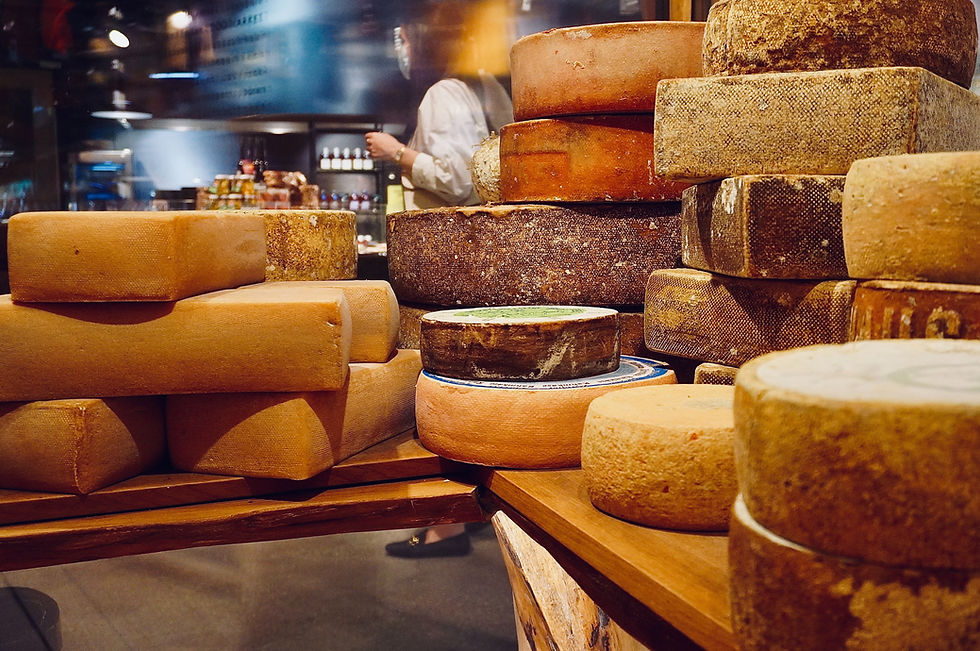Italian cheeses: the gift that keeps on giving
- teresacolorschef
- Oct 3, 2023
- 4 min read
Updated: Oct 5, 2023
Cow, sheep, goat? It can be overwhelming to even know where to begin! Here is my short summary of what you need to know about this delightful food.

I can count on one hand the number of people I know who don't like cheese. And what is there not to like? Whether on a beautiful charcuterie board to enjoy with a cold glass of wine, in a much-needed sandwich on your hike, or sprinkled on your favorite pasta dish - cheese is among the most enjoyable foods there is.
Although Italy produces one third of Europe's cheese (after France and Germany), it boasts many more varieties than its northern cousins. With an astounding 2,500 "tipologie", you could live in Italy your whole life and still not taste them all!
To cheese or not to cheese
Did you know that there is a difference between cheese (formaggio) and dairy products (latticino)?
Cheeses are made from whole or non-whole milk with the addition of salt and enzymes. Cheeses are generally richer and more calorie dense than dairy products
Dairy products are the result of curd processing: meaning that the 'cheese' they produce is the result of processing the waste of actual cheesemaking. Ricotta is a typical example of this (besides the more obvious non-cheese products such as butter, yogurt, cream and kefir). Dairy products are lighter and more digestible
Know what's on your plate
Understanding a little background on the different types of cheeses will really go a long way in helping you to enjoy the endless variety you will find on your travels (in Italy and beyond!).
Let's look at some of the basics:
Animal: in Italy, cheeses are made with cow's milk (more typical in northern Italy); goat & sheep milk (central, south as well as Sicily and Sardinia) and buffalo milk (central west).
Heat treatment: cheeses can be made with either raw milk or pasteurised milk. At the supermarket most of the cheese will be pasteurised as they will often travel many kilometres (but its worth asking for "Un formaggio a latte crudo" if you want to see if your local store carried raw milk options. Raw milk cheeses - as they are not treated with heat - are rich in vitamins (A, C and D), minerals (calcium & iron) as well as proteins and fats. These kinds of cheeses come from well respected farms which prioritise both animal well-being as well as hygiene standards. A great example is Alpine pasture cheese, which is characterised by the plants and herbs that the cattle will naturally find in the mountains - and must be tasted!
Consistency & age: cheeses can be soft, semi hard and hard and have different rinds - all of this will affect the taste and your preferences. Here is a short summary including Italian examples for each category:
Soft (mascarpone, mozzarella): typically young, soft or spreadable, with a fresh light taste (ricotta, mascarpone, mozzarella). Made in 1-2 days they can be eaten immediately.
Bloomy-rind (tomino, paglierina): edible yet tangy rind with a slightly more compact cheese compared to its softer cousin. Whilst the french cheese are most known for this feature (camembert/brie) Italy also produces some.
Washed-rind (taleggio): somewhat sticky rind often also showing some coloration depending on the wash of choice (can include brine, cider, beer, wine etc). Flavor will be more funky and earthy.
Semi-soft (fontina): most popular for their versatility and mildness of taste. Perfect for incorporating into recipes or melt on sandwiches, or to serve up on a cheese board to pair with pickled vegetables and marmalades.
Blue (Gorgonzola): a love-it-or-hate-it category, these cheeses gain their blue/green veins thanks to a treatment with different strains of penicillium. Honey and nuts can help balance out the pungent flavor.
Semi-hard (pecorino, primo sale): a very broad category including different levels of ageing and lots of flavour profiles: from warm and nutty to tangy and bitter
Hard (Parmigiano Reggiano): aged for months if not years, these cheeses have very concentrated flavor profiles and often crumbly texture. Enjoy them with fatty meats or special jams to really unlock all their notes.
Lactose intolerance? You still have options!
Besides the lactose free options available at your local supermarket, it's worthwhile knowing that many Italian cheeses are naturally low in lactose, and so can be enjoyed even if you have an intolerance. * NB this is not helpful for those who are allergic!
Lactose free (>0.01% lactose) | Rich in lactic bacteria (that can break down lactose) | High lactose content (choose lactose free version) |
Montasio, Gorgonzola, Grana Padano, Fontina, Pecorino (36 months), Sweet & Smoked Provolone | Asiago, Caciocavallo, Caciotta, Caprino, Feta, Fiordilatte, Quark, Taleggio & Toma | Mozzarella, any spreadable cheese, Certosino, Cottage Cheese & Ricotta |
Teresa's Top Tips
Visit your local market and head for the cheese stand, often the vendor will let you sample different types of cheese & if you're lucky they might speak some English to explain the background! If you want a guided tour of your weekly market check out my calendar to see when I'm doing my next tour. If you don't see a fixed date reach out & we can arrange a tour just for you!
Get adventurous and visit specialty shops in your local area, some that I highly recommend include Latteria di Marsure, Azienda Agricola San Gregorio (Aviano), in Budoia you can also check out a cheese, milk & butter vending machine set up by a local farmer - fresh is best! Distributore Latte Fresco e Formaggi.
Always taste on your travels. Whether in Italy or aboard, the beauty of cheesemaking is that no two are alike! Always take the opportunity of trying the locally made stuff, you will rarely regret it!




Comments